1988 PONTIAC FIERO window
[x] Cancel search: windowPage 1736 of 1825
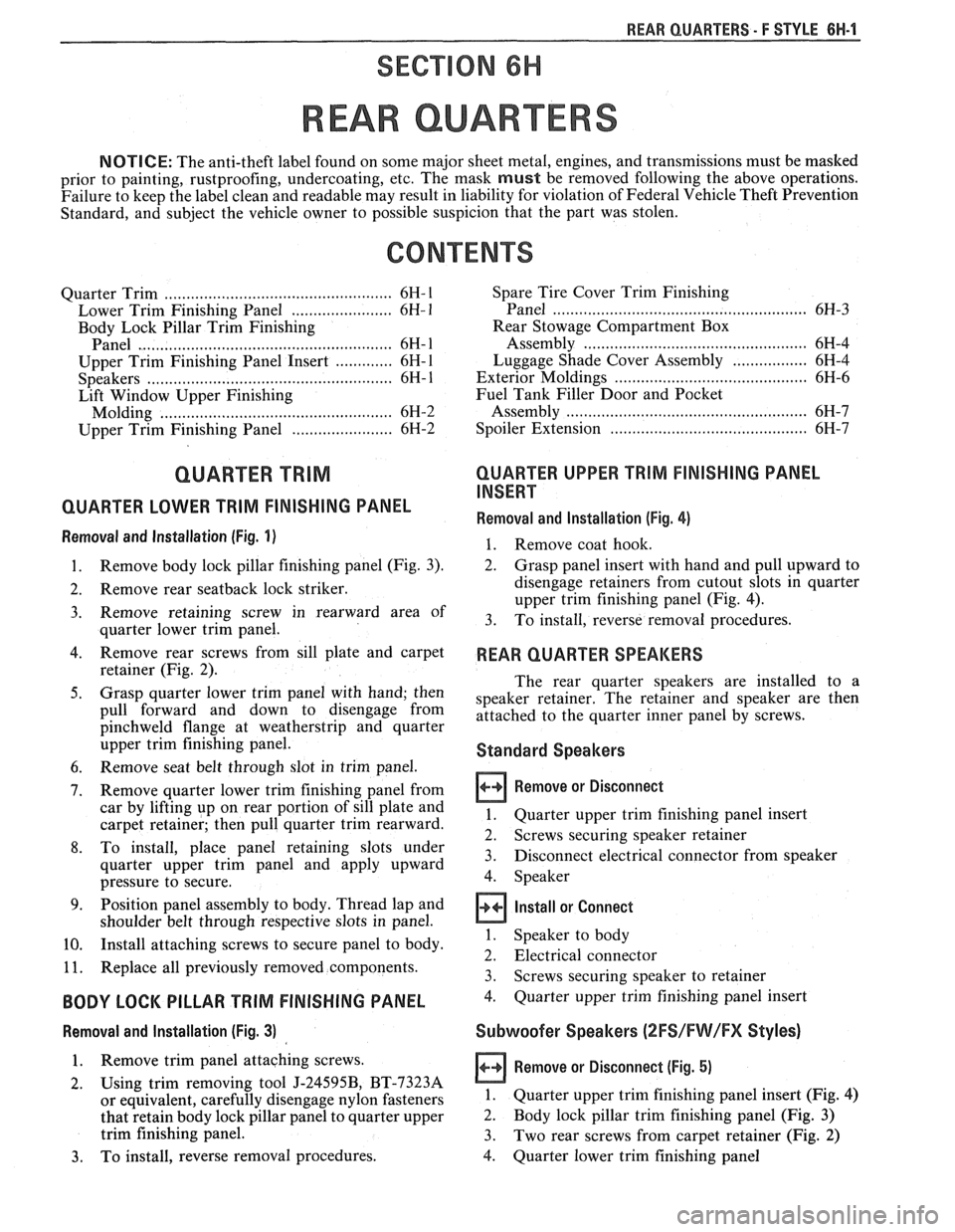
REAR QUARTERS - F STYLE 8H-1
SECTION 6H
REAR QUARTERS
NOTICE: The anti-theft label found on some major sheet metal, engines, and transmissions must be masked
prior to painting, rustproofing, undercoating, etc. The mask
must be removed following the above operations.
Failure to keep the label clean and readable may result in liability for violation of Federal Vehicle Theft Prevention
Standard, and subject the vehicle owner to possible suspicion that the part was stolen.
CONTENTS
Quarter Trim .................................................... 6H- 1
Lower Trim Finishing Panel ....................... 6H- 1
Body Lock Pillar Trim Finishing
Panel
., ....................................................... 6H- 1
Upper Trim Finishing Panel Insert ............. 6H- 1
....................................................... Speakers 6H- 1
Lift Window Upper Finishing
Molding
..................................................... 6H-2
....................... Upper Trim Finishing Panel 6H-2
QUARTER TRlM
QUARTER LOWER TRlM FINISHING PANEL
Removal and Installation (Fig. 1)
Remove body lock pillar finishing panel (Fig. 3).
Remove rear
seatback lock striker.
Remove retaining screw in rearward area of
quarter lower trim panel.
Remove rear screws from sill plate and carpet
retainer (Fig.
2).
Grasp quarter lower trim panel with hand; then
pull forward and down to disengage from
pinchweld flange at weatherstrip and quarter
upper trim finishing panel.
Remove seat belt through slot in trim panel.
Remove quarter lower trim finishing panel from
car by lifting up on rear portion of sill plate and
carpet retainer; then pull quarter trim rearward.
To install, place panel retaining slots under
quarter upper trim panel and apply upward
pressure to secure.
Position panel assembly to body. Thread lap and
shoulder belt through respective slots in panel.
Install attaching screws to secure panel to body.
Replace all previously removed components.
BODY LOCK PILLAR TRlM FINISHING PANEL
Removal and lnstallation (Fig. 3)
1. Remove trim panel attaching screws.
2. Using trim removing tool J-24595B, BT-7323A
or equivalent, carefully disengage nylon fasteners
that retain body lock pillar panel to quarter upper
trim finishing panel.
3. To install, reverse removal procedures. Spare
Tire Cover Trim Finishing
Panel
........................................................ 6H-3
Rear Stowage Compartment Box
Assembly
................................................... 6H-4
Luggage Shade Cover Assembly
................. 6H-4
Exterior Moldings
........................................... 6H-6
Fuel Tank Filler Door and Pocket
Assembly
....................................................... 6H-7
Spoiler Extension
............................ .. ........... 6H-7
QUARTER UPPER TRlM FINISHING PANEL
INSERT
Removal and Installation (Fig. 4)
1. Remove coat hook.
2. Grasp panel insert with hand and pull upward to
disengage retainers from cutout slots in quarter
upper trim finishing panel (Fig. 4).
3. To install, reverse removal procedures.
REAR QUARTER SPEAKERS
The rear quarter speakers are installed to a
speaker retainer. The retainer and speaker are then
attached to the quarter inner panel by screws.
Standard Speakers
Remove or Disconnect
1. Quarter upper trim finishing panel insert
2. Screws securing speaker retainer
3. Disconnect electrical
connector from speaker
4. Speaker
Install or Connect
1. Speaker to body
2. Electrical connector
3. Screws securing speaker to retainer
4. Quarter upper trim finishing panel insert
Subwoofer Speakers (2FS/FW/FX Styles)
Remove or Disconnect (Fig. 5)
1.
Quarter upper trim finishing panel insert (Fig. 4)
2. Body lock pillar trim finishing panel (Fig. 3)
3. Two rear screws from carpet retainer (Fig.
2)
4.
Quarter lower trim finishing panel
Page 1737 of 1825
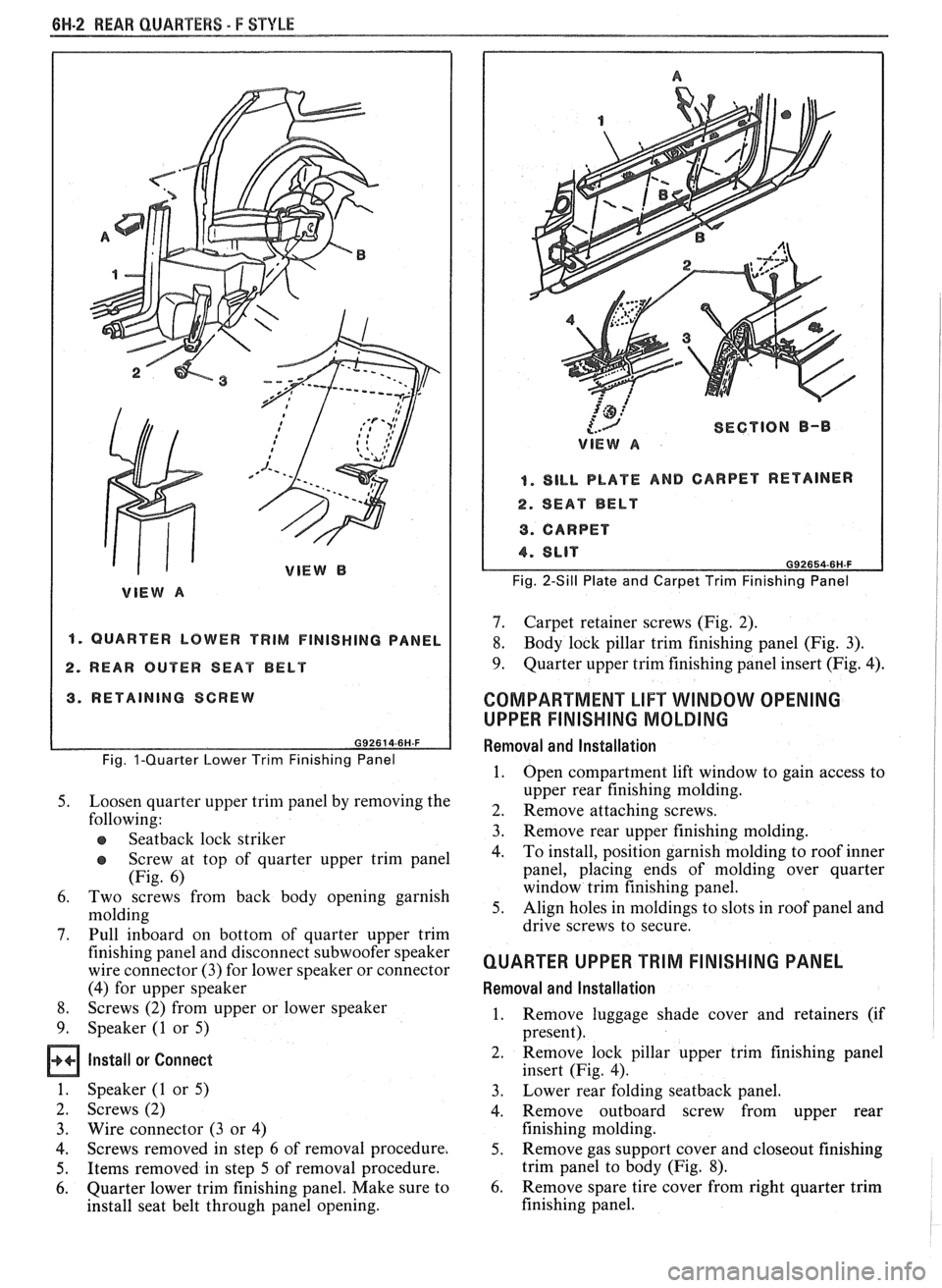
661-2 REAR QUARTERS - F STYLE
"1 QUARTER LOWER TRIM FINISHING PANEL
2. REAR OUTER SEAT BELT
3. RETAINING SCREW
Fig. I-Quarter Lower Trim Finishing Panel
5. Loosen quarter upper trim panel by removing the
following:
e Seatback lock striker
@ Screw at top of quarter upper trim panel
(Fig. 6)
6. Two screws from back body opening garnish
molding
7. Pull inboard on bottom of quarter upper trim
finishing panel and disconnect subwoofer speaker
wire connector (3) for lower speaker or connector
(4) for upper speaker
8. Screws (2) from upper or lower speaker
9. Speaker (1 or 5)
Install or Connect
1. Speaker (1 or 5)
2. Screws (2)
3. Wire connector
(3 or 4)
4. Screws removed
in step 6 of removal procedure.
5. Items removed in step 5 of removal procedure.
6. Quarter lower trim finishing panel. Make sure to
install seat belt through panel opening.
'@ ,:'
{.-J SECTION B-I)
VIEW A
I. SILL PLATE AND CARPET RETAINER
4. SEAT BELT
9. CARPET
Fig. 2-Sill Plate and Carpet Trim Finishing Panel
7. Carpet retainer screws (Fig. 2).
8. Body lock pillar trim finishing panel (Fig. 3).
9. Quarter upper trim finishing panel insert (Fig. 4).
COMPARTMENT LIFT WINDOW OPENING
UPPER
FINISHING MOLDING
Removal and lnstallation
1. Open compartment lift window to gain access to
upper rear finishing molding.
2. Remove attaching screws.
3. Remove rear upper
finishing molding.
4. To
install, position garnish molding to roof inner
panel, placing ends of molding over quarter
window trim finishing panel.
5. Align holes in moldings to slots in roof panel and
drive screws to secure.
QUARTER UPPER TRIM FINISHING PANEL
Removal and Installation
1. Remove
luggage shade cover and retainers (if
present).
2. Remove
lock pillar upper trim finishing panel
insert (Fig. 4).
3. Lower
rear folding
seatback panel.
4. Remove outboard screw from upper rear
finishing molding.
5. Remove gas support cover and closeout finishing
trim panel to body (Fig.
8).
6. Remove spare tire cover from right quarter trim
finishing panel.
Page 1739 of 1825
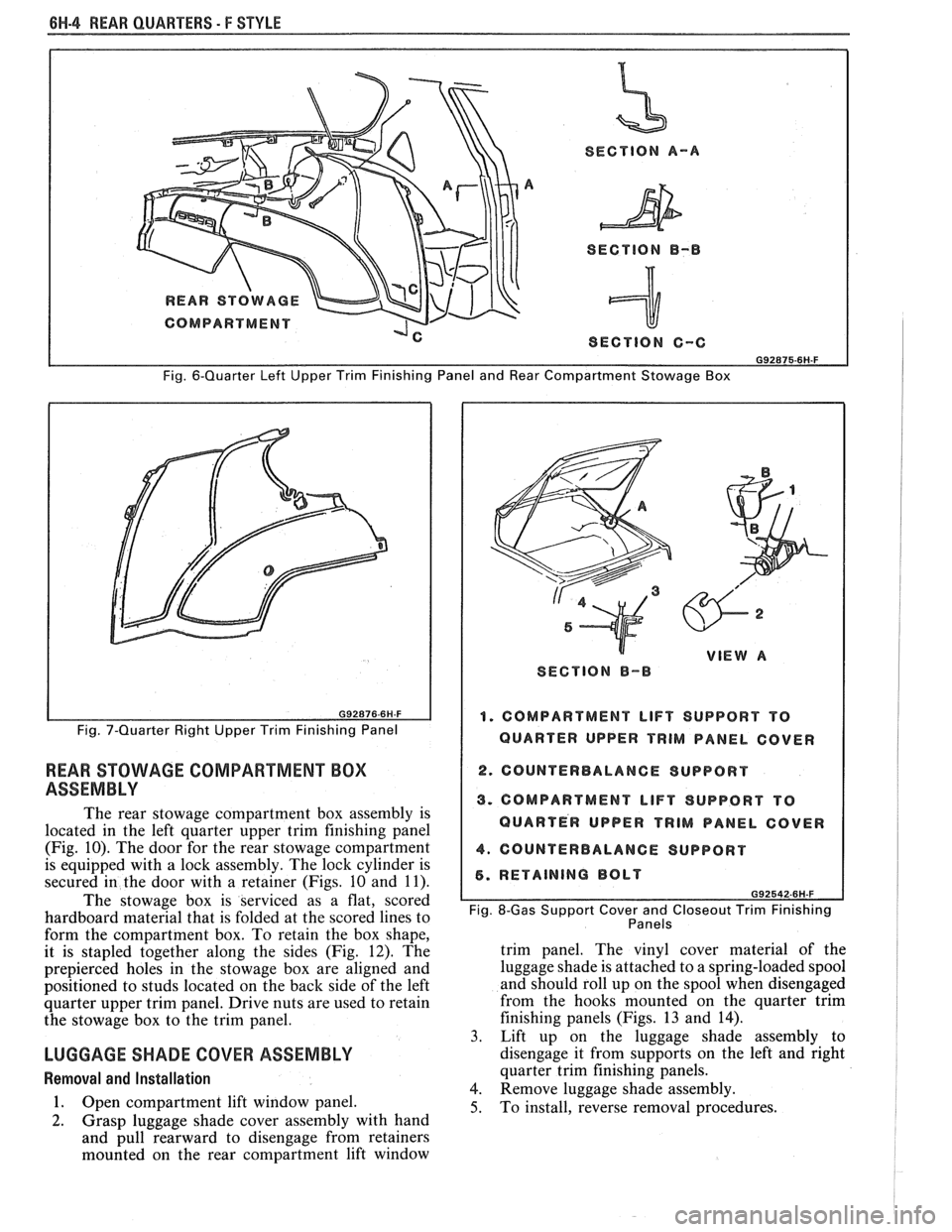
BH-4 REAR QUARTERS - F STYLE
SECTION A-A
SECTION
B-B
I SECTION C-C I
Fig. 6-Quarter Left Upper Trim Finishing Panel and Rear Compartment Stowage Box
Fig. 7-Quarter Right Upper Trim Finishing Panel
REAR STOWAGE COMPARTMENT BOX
ASSEMBLY
The rear stowage compartment box assembly is
located in the left quarter upper trim finishing panel
(Fig. 10). The door for the rear stowage compartment
is equipped with a lock assembly. The lock cylinder is
secured in the door with a retainer (Figs. 10 and 11).
The stowage box is serviced as a flat, scored
hardboard material that is folded at the scored lines to
form the compartment box. To retain the box shape,
it is stapled together along the sides (Fig. 12). The
prepierced holes in the stowage box are aligned and
positioned to studs located on the back side of the left
quarter upper trim panel. Drive nuts are used to retain
the stowage box to the trim panel.
LUGGAGE SHADE COVER ASSEMBLY
Removal and Installation
1. Open compartment lift window panel.
2. Grasp luggage shade cover assembly with hand
and pull rearward to disengage from retainers
mounted on the rear compartment lift window
W VIEW A
SECTION 8-B
1. COMPARTMENT LIFT SUPPORT TO
QUARTER UPPER
TRIM PANEL COVER
2. COUNTERBALANCE SUPPORT I
3. COMPARTMENT LIFT SUPPORT TO
QUARTER UPPER
TRIM PANEL COVER
4. COUNTERBALANCE SUPPORT I
5. RETAINING BOLT
Fig. 8-Gas Support Cover and Closeout Trim Finishing
Panels
trim panel. The vinyl cover material of the
luggage shade is attached to a spring-loaded spool
and should roll up on the spool when disengaged
from the hooks mounted on the quarter trim
finishing panels (Figs. 13 and
14).
3. Lift up on the luggage shade assembly to
disengage it from supports on the left and right
quarter trim finishing panels.
4. Remove luggage shade assembly.
5. To install, reverse removal procedures.
Page 1742 of 1825
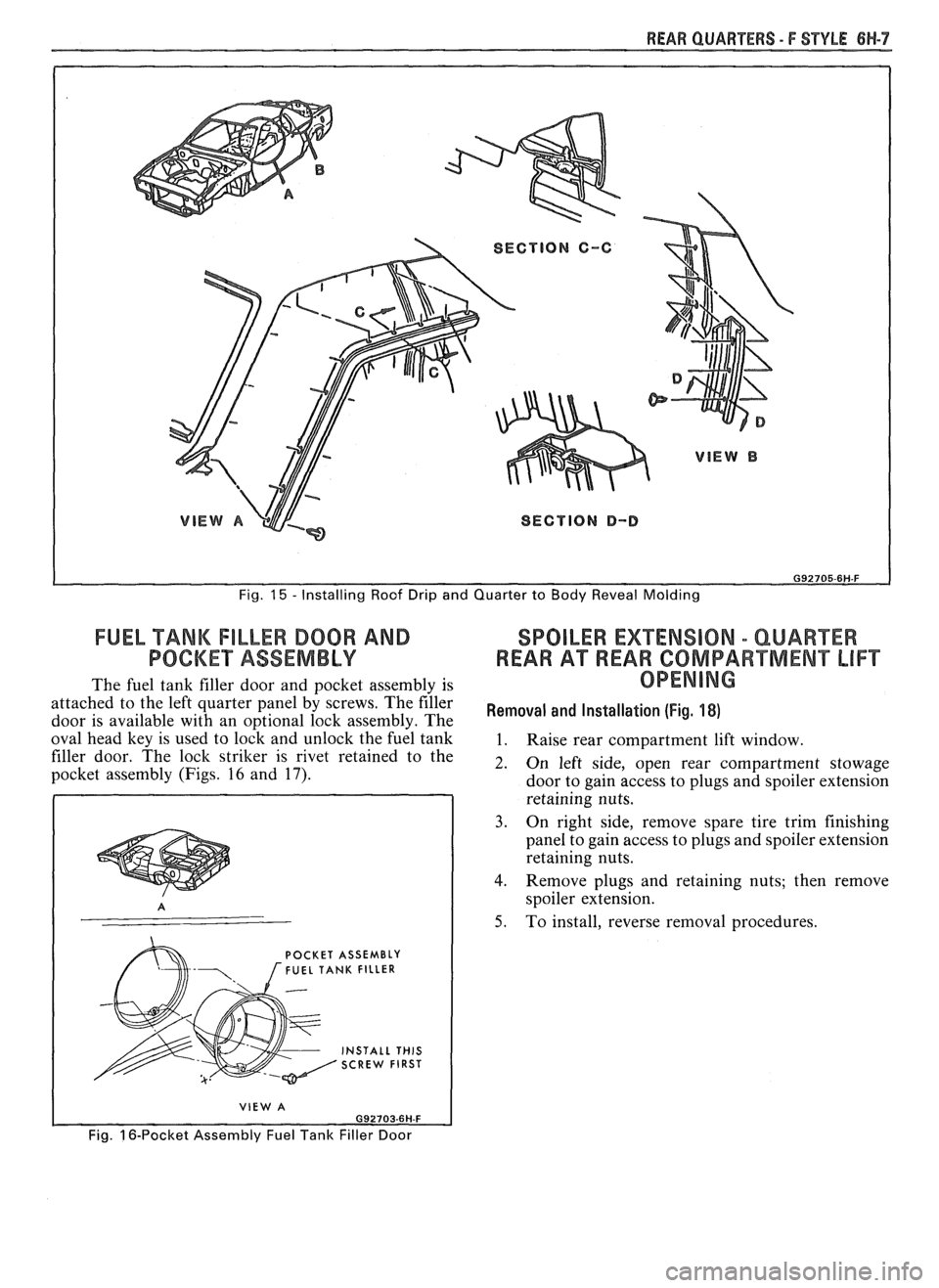
REAR QUARTERS - F STYLE 6N-7
Fig. 15 - Installing Roof Drip and Quarter to Body Reveal Molding
FUEL TANK FILLER DOOR AND SPOILER EXTENSION - QUAREER
POCKET ASSEMBLY REAR A"FREAR COMPARTMENT LIFT
The fuel tank filler door and pocket assembly is OPENING
attached to the left quarter panel by screws. The filer Removal and (Fig, door is available with an o~tional lock assemblv. The
oval head key is used to
loik and unlock the fuil tank 1. Raise rear compartment lift window.
filler door. The lock striker is rivet retained to the
2. 0, left side, open rear compartment stowage pocket assembly (Figs. 16 and 17). door to gain access to plugs and spoiler extension
retaining nuts.
3. On right side, remove spare tire trim finishing
panel to gain access to plugs and spoiler extension
retaining nuts.
4. Remove plugs and retaining nuts; then remove
spoiler extension.
5. To install, reverse removal procedures.
POCKET ASSEMBLY FUEL TANK FILLER
INSTALL THIS SCREW FIRST
VIEW A
Fig. 16-Pocket Assembly Fuel Tank Filler Door
Page 1744 of 1825
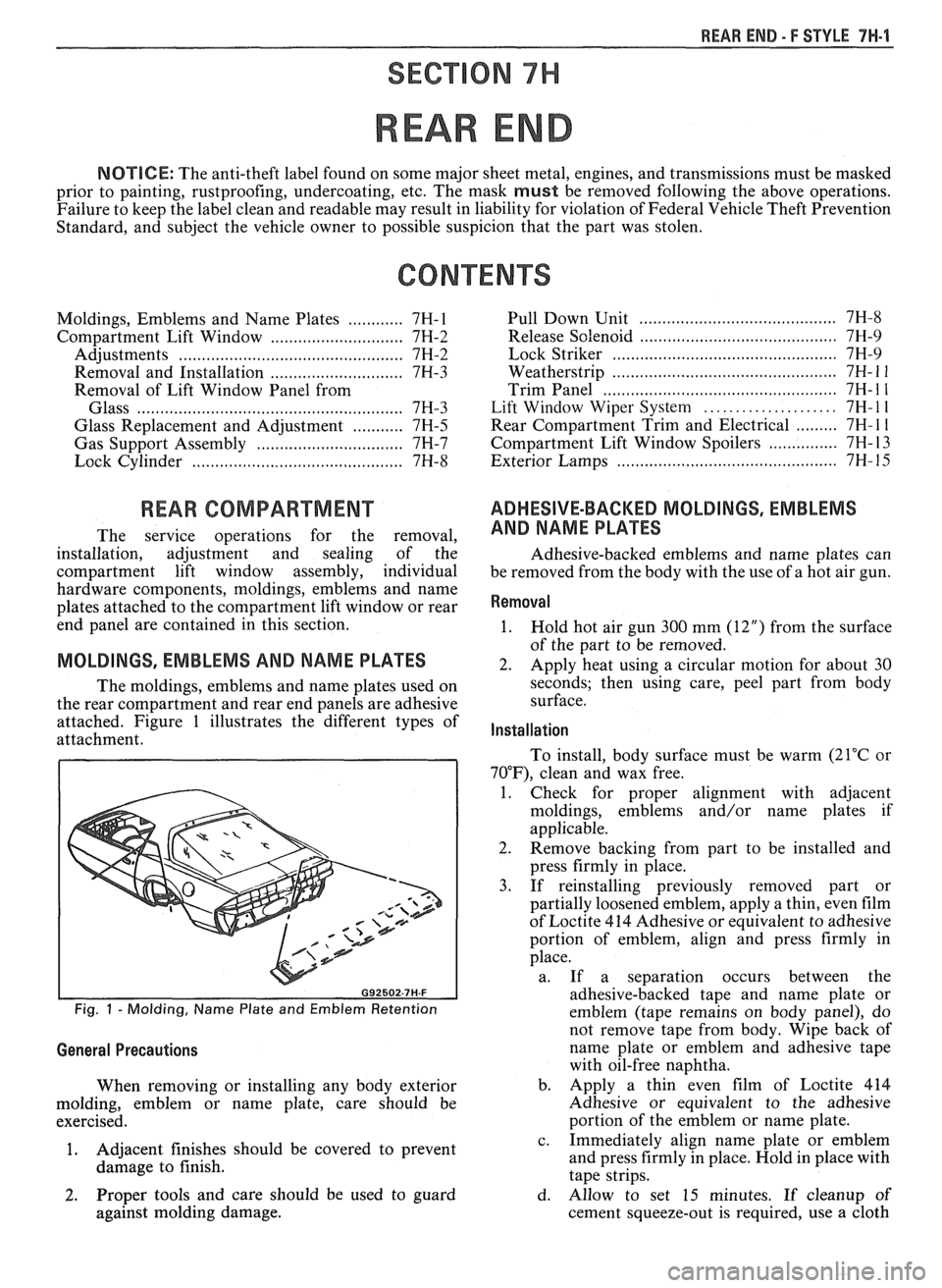
REAR END - F STYLE 7H-1
SECTION 7H
REAR END
NOTICE: The anti-theft label found on some major sheet metal, engines, and transmissions must be masked
prior to painting, rustproofing, undercoating, etc. The mask
must be removed following the above operations.
Failure to keep the label clean and readable may result in liability for violation of Federal Vehicle Theft Prevention
Standard, and subject the vehicle owner to possible suspicion that the part was stolen.
CONTENTS
Moldings, Emblems and Name Plates ............ 7H- 1
Compartment Lift Window
.......................... ... 7H-2
Adjustments ........................... .. ................ 7H-2
Removal and Installation ............................. 7H-3
Removal of Lift Window Panel from
Glass
....................................................... 7H-3
Glass Replacement and Adjustment ........... 7H-5
Gas Support Assembly ............................. 7H-7
Lock Cylinder ....................... .. .............. 7H-8
REAR COMPARTMENT
The service operations for the removal,
installation, adjustment and sealing of the
compartment lift window assembly, individual
hardware components, moldings, emblems and name
plates attached to the compartment lift window or rear
end panel are contained in this section.
MOLDINGS, EMBLEMS AND NAME PLAES
The moldings, emblems and name plates used on
the rear compartment and rear end panels are adhesive
attached. Figure 1 illustrates the different types of
attachment.
Fig. 1 - Molding, Name Plate and Emblem Retention
General Precautions
When removing or installing any body exterior
molding, emblem or name plate, care should be
exercised.
1. Adjacent
finishes should be covered to prevent
damage to finish.
...................................... Pull Down Unit 7H-8
.......................................... Release Solenoid 7H-9
......... ..................................... Lock Striker ... 7H-9
................... ....................... Weatherstrip .. 7H- 1 1
.................................................. Trim Panel 7H- 1 1
..................... Lift Window Wiper System 7H- l l
......... Rear Compartment Trim and Electrical 7H- 1 1
............... Compartment Lift Window Spoilers 7H- 13
.......................................... Exterior Lamps 7H- 15
ADHESIVE-BACKED MOLDINGS, EMBLEMS
AND NAME PLATES
Adhesive-backed emblems and name plates can
be removed from the body with the use of a hot air gun.
Removal
1.
Hold hot air gun 300 mm (12") from the surface
of the part to be removed.
2. Apply heat using a circular motion for about 30
seconds; then using care, peel part from body
surface.
Installation
To install, body surface must be warm (21°C or
70"F), clean and wax free.
1. Check for proper alignment with adjacent
moldings, emblems and/or name plates if
applicable.
2. Remove backing from part to be installed and
press firmly in place.
3. If reinstalling previously removed part or
partially loosened emblem, apply a thin, even film
of Loctite 414 Adhesive or equivalent to adhesive
portion of emblem, align and press firmly in
place.
a. If a separation occurs between the
adhesive-backed tape and name plate or
emblem (tape remains on body panel), do
not remove tape from body. Wipe back of
name plate or emblem and adhesive tape
with oil-free naphtha.
b. Apply a thin even film of Loctite 414
Adhesive or equivalent to the adhesive
portion of the emblem or name plate.
c. Immediately align name plate or emblem
and press firmly in place. Hold in place with
tape strips.
2. Proper tools and care should be used to guard d. Allow to set 15 minutes. If cleanup of
against molding damage. cement squeeze-out is required, use a cloth
Page 1745 of 1825
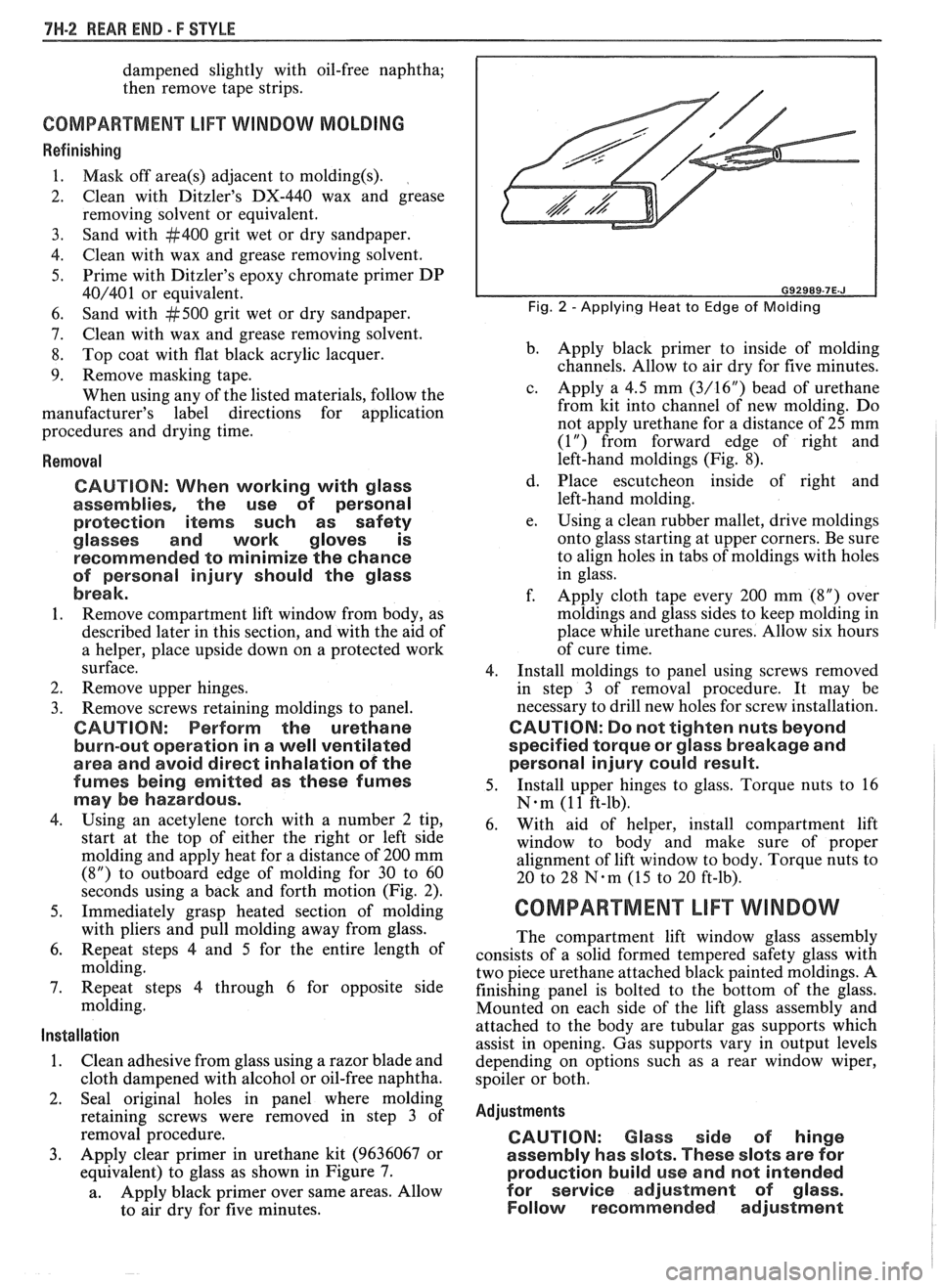
71.1-2 REAR END - F STYLE
dampened slightly with oil-free naphtha;
then remove tape strips.
COMPARTMENT LIFT WINDOW MOLDING
Refinishing
1. Mask off area(s) adjacent to molding(s).
2. Clean with Ditzler's DX-440 wax and grease
removing solvent or equivalent.
3. Sand with
#400 grit wet or dry sandpaper.
4. Clean
with wax and grease removing solvent.
5. Prime with Ditzler's
epoxy chromate primer DP
40/40 1 or equivalent.
6. Sand with
#500 grit wet or dry sandpaper.
7. Clean with wax and grease removing solvent.
8. Top
coat with flat black acrylic lacquer.
9. Remove masking tape.
When using any of the listed materials, follow the
manufacturer's label directions for application
procedures and drying time.
Removal
CAUTION: When working with glass
assemblies, the use of personal
protection items such as safety
glasses and work gloves is
recommended to minimize the chance
of personal injury should the glass
break.
1. Remove compartment lift window from body, as
described later in this section, and with the aid of
a helper, place upside down on a protected work
surface.
2. Remove upper hinges.
3. Remove screws retaining moldings to panel.
CAUTION: Perform the urethane
burn-out operation in a well ventilated
area and avoid direct inhalation of the
fumes being emitted as these fumes
may be hazardous.
4. Using an acetylene torch with a number 2 tip,
start at the top of either the right or left side
molding and apply heat for a distance of 200 mm
(8") to outboard edge of molding for 30 to 60
seconds using a back and forth motion (Fig. 2).
5. Immediately grasp heated section of molding
with pliers and pull molding away from glass.
6. Repeat steps
4 and 5 for the entire length of
molding.
7. Repeat steps 4 through 6 for opposite side
molding.
Installation
1. Clean adhesive from glass using a razor blade and
cloth dampened with alcohol or oil-free naphtha.
2. Seal original holes in panel where molding
retaining screws were removed in step 3 of
removal procedure.
3. Apply clear primer in urethane kit (9636067 or
equivalent) to glass as shown in Figure 7.
a. Apply
black primer over same areas. Allow
to air dry for five minutes.
Fig. 2 -Applying Heat to Edge of Molding
b. Apply
black primer to inside of molding
channels. Allow to air dry for five minutes.
c. Apply a 4.5 mm
(3/16") bead of urethane
from kit into channel of new molding. Do
not apply urethane for a distance of
25 mm
(1") from forward edge of right and
left-hand moldings (Fig. 8).
d. Place escutcheon inside of right and
left-hand molding.
e. Using a
clean rubber mallet, drive moldings
onto glass starting at upper corners. Be sure
to align holes in tabs of moldings with holes
in glass.
f. Apply cloth tape every 200 mm (8") over
moldings and glass sides to keep molding in
place while urethane cures. Allow six hours
of cure time.
4. Install moldings to panel using screws removed
in step 3 of removal procedure. It may be
necessary to drill new holes for screw installation.
CAUTION: Do not tighten nuts beyond
specified torque or glass breakage and
personal injury could result.
5. Install
upper hinges to glass. Torque nuts to 16
N-m (1 1 ft-lb).
6. With aid of helper, install compartment lift
window to body and make sure of proper
alignment of lift window to body. Torque nuts to
20 to 28
N-m (15 to 20 ft-lb).
COMPARTMENT LIFT WINDOW
The compartment lift window glass assembly
consists of a solid formed tempered safety glass with
two piece urethane attached black painted moldings. A
finishing panel is bolted to the bottom of the glass.
Mounted on each side of the lift glass assembly and
attached to the body are tubular gas supports which
assist in opening. Gas supports vary in output levels
depending on options such as a rear window wiper,
spoiler or both.
Adjustments
CAUTION: Glass side of hinge
assembly has slots. These slots are for
production build use and not intended
for service adjustment of
glass.
Follow recommended adjustment
Page 1746 of 1825
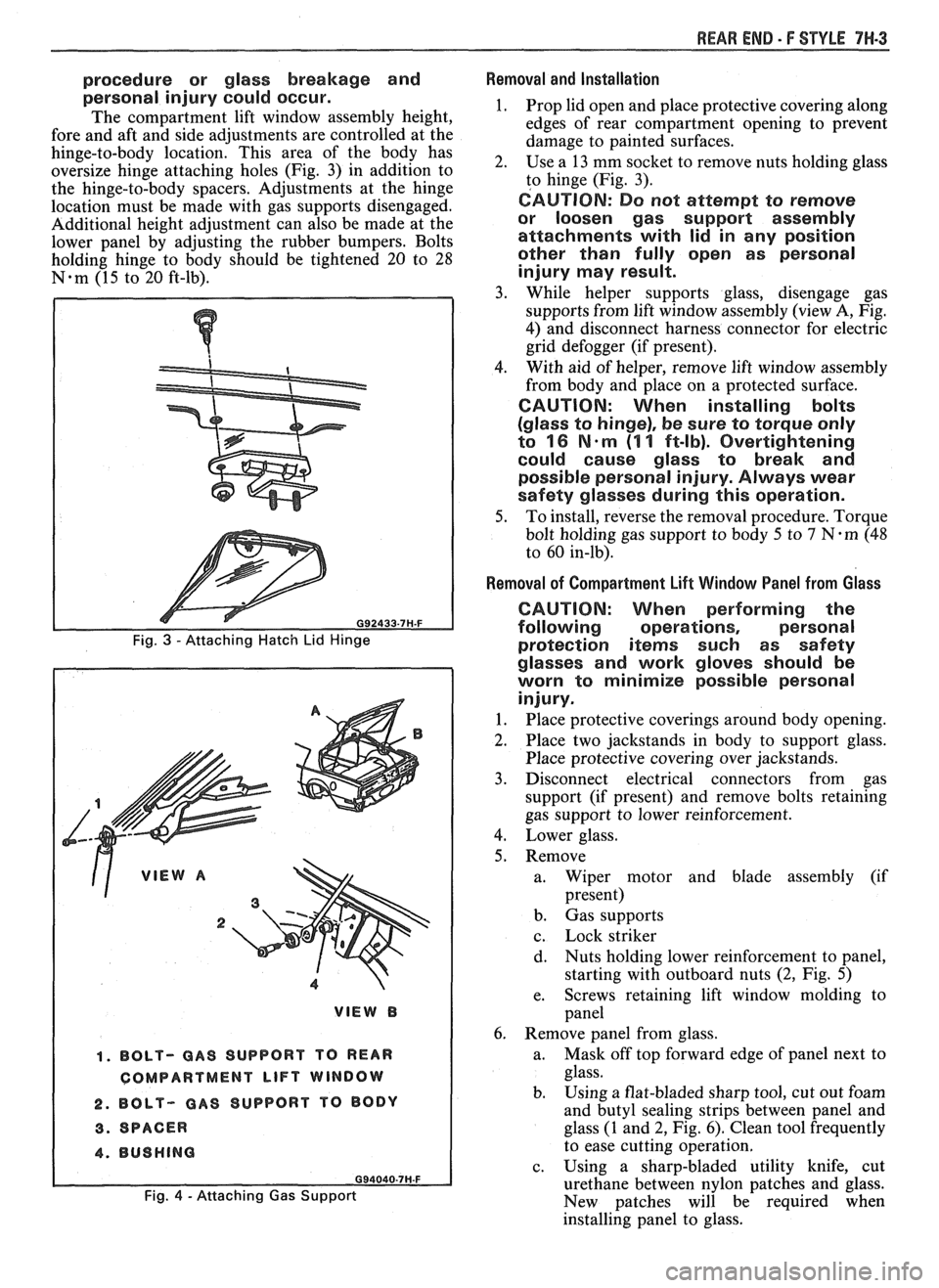
procedure or glass breakage and
personal injury could occur.
The compartment lift window assembly height,
fore and aft and side adjustments are controlled at the
hinge-to-body location. This area of the body has
oversize hinge attaching holes (Fig. 3) in addition to
the hinge-to-body spacers. Adjustments at the hinge
location must be made with gas supports disengaged.
Additional height adjustment can also be made at the
lower panel by adjusting the rubber bumpers. Bolts
holding hinge to body should be tightened 20 to 28
N-m (15 to 20 ft-lb).
, ,' VIEW A
2
1. BOLT- GAS SUPPORT TO REAR
COMPARTMENT
LIFT WINDOW
2. BOLT- GAS SUPPORT
TO BODY
3. SPACER
4. BUSHING
Fig. 4 - Attaching Gas Support
REAR END - F STYLE 7W-3
Removal and Installation
1. Prop lid open and place protective covering along
edges of rear compartment opening to prevent
damage to painted surfaces.
2. Use
a 13 mm socket to remove nuts holding glass
to hinge (Fig. 3).
CAUTION: Do not attempt to remove
or loosen gas support assembly
attachments with lid in any position
other than fully open as personal
injury may result.
3. While helper supports glass, disengage gas
supports from lift window assembly (view A, Fig.
4) and disconnect harness connector for electric
grid defogger (if present).
4. With
aid of helper, remove lift window assembly
from body and place on a protected surface.
CAUTION: When installing bolts
(glass to hinge), be sure to torque only
to
16 N-m (1 1 ft-lb). Overtightening
could cause glass to break and
possible personal injury. Always wear
safety glasses during this operation.
5. To install, reverse the removal procedure. Torque
bolt holding gas support to body 5 to
7 N-m (48
to 60 in-lb).
Removal of Compartment Lift Window Panel from Glass
CAUTION: When performing the
following operations, personal
protection
iterns such as safety
glasses and work gloves should be
worn to minimize possible personal
injury.
1. Place protective coverings around body opening.
2. Place two jackstands in body to support glass.
Place protective covering over jackstands.
3. Disconnect electrical connectors from gas
support (if present) and remove bolts retaining
gas support to lower reinforcement.
4. Lower glass.
5. Remove a. Wiper motor and blade assembly (if
present)
b. Gas supports
c. Lock striker
d. Nuts
holding lower reinforcement to panel,
starting with outboard nuts
(2, Fig. 5)
e. Screws
retaining lift window molding to
panel
6. Remove panel from glass.
a. Mask
off top forward edge of panel next to
glass.
b. Using
a flat-bladed sharp tool, cut out foam
and butyl sealing strips between panel and
glass (1 and 2, Fig. 6). Clean tool frequently
to ease cutting operation.
c. Using a sharp-bladed utility knife, cut
urethane between nylon patches and glass.
New patches will be required when
installing panel to glass.
Page 1747 of 1825
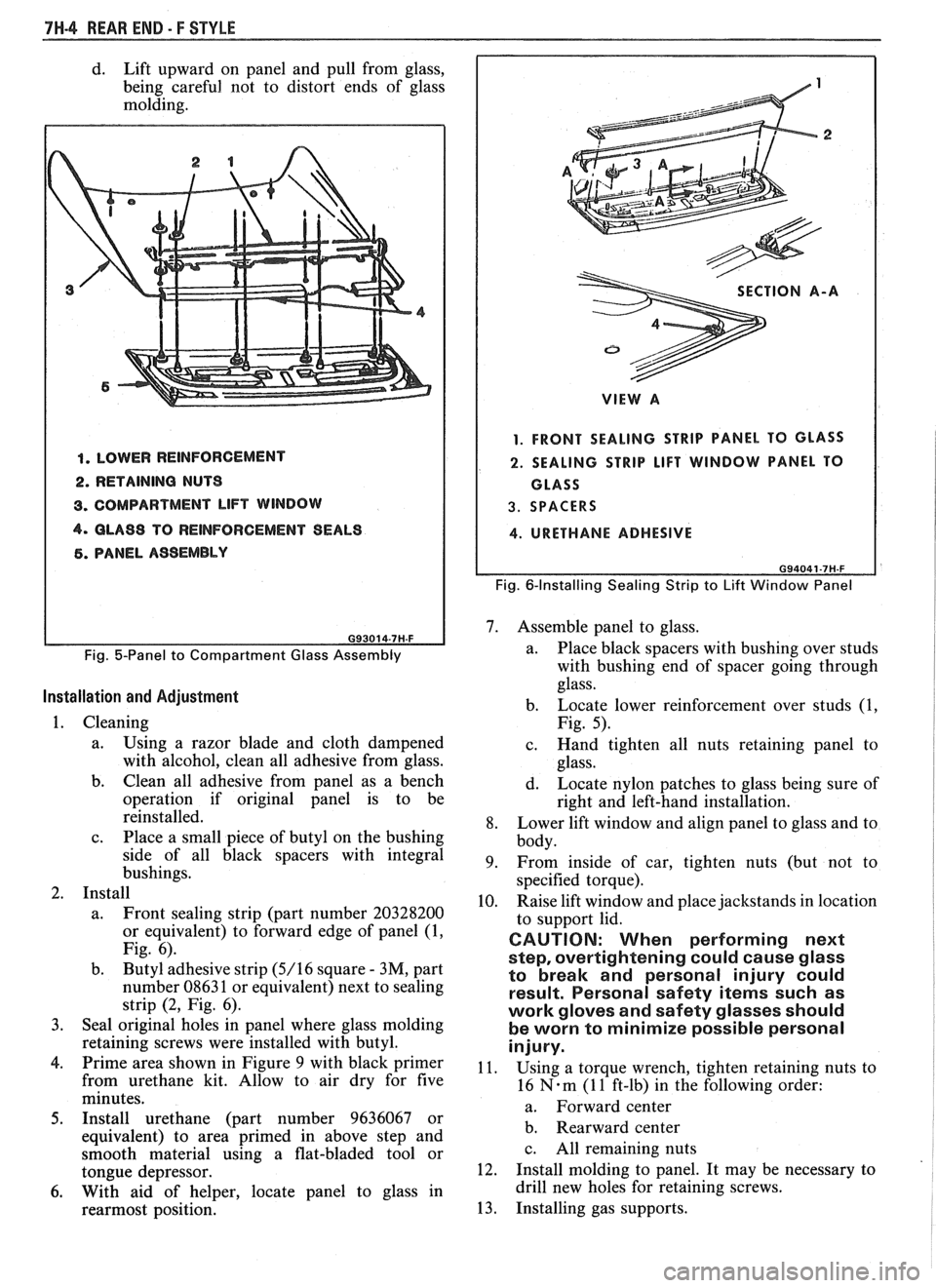
7H-4 REAR END - F STYLE
d. Lift upward on panel and pull from glass,
being careful not to distort ends of glass
molding.
1. LOWER REINFORCEMENT
2. RETAINING NUTS
3. COMPARTMENT LIFT WINDOW
4. GLASS TO REINFORCEMENT SEALS
5. PANEL ASSEMBLY
Fig. 5-Panel to Compartment Glass Assembly
Installation and Adjustment
1. Cleaning
a. Using
a razor blade and cloth dampened
with alcohol, clean all adhesive from glass.
b. Clean all adhesive from panel as a bench
operation if original panel is to be
reinstalled.
c. Place a small piece of butyl on the bushing
side of all black spacers with integral
bushings.
2. Install
a. Front sealing strip (part number 20328200
or equivalent) to forward edge of panel (1,
Fig. 6).
b. Butyl adhesive strip
(5/16 square - 3M, part
number 0863 1 or equivalent) next to sealing
strip (2, Fig. 6).
3. Seal original holes in panel where glass molding
retaining screws were installed with butyl.
4. Prime area shown in Figure 9 with black primer
from urethane kit. Allow to air dry for five
minutes.
5. Install urethane (part number 9636067 or
equivalent) to area primed in above step and
smooth material using a flat-bladed tool or
tongue depressor.
6. With aid of helper, locate panel to glass in
rearmost position.
VIEW A
1. FRONT SEALING STRIP PANEL TO GLASS
2. SEALING STRIP LIFT WINDOW PANEL TO
GLASS
3. SPACERS
4. URETHANE ADHESIVE
G94041-7H-F
Fig. 6-Installing Sealing Strip to Lift Window Panel
7. Assemble panel to glass.
a. Place black spacers with bushing over studs
with bushing end of spacer going through
glass.
b. Locate lower reinforcement over studs (1,
Fig.
5).
c. Hand tighten all nuts retaining panel to
glass.
d. Locate nylon patches to glass being sure of
right and left-hand installation.
8. Lower lift window and align panel to glass and to
body.
9. From
inside of car, tighten nuts (but not to
specified torque).
10. Raise
lift window and place jackstands in location
to support lid.
CAUTION: When performing next
step,
overtightening could cause glass
to break and personal injury could
result. Personal safety items such as
work gloves and safety glasses should
be worn to minimize possible personal
injury.
11. Using
a torque wrench, tighten retaining nuts to
16
N.m (1 1 ft-lb) in the following order:
a. Forward center
b. Rearward center
c. All remaining nuts
12. Install
molding to panel. It may be necessary to
drill new holes for retaining screws.
13. Installing gas supports.